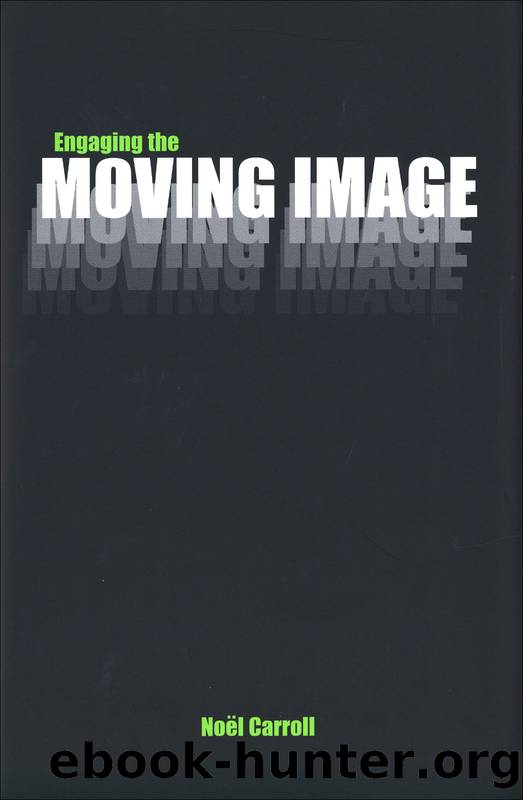Engaging the Moving Image by Carroll Noël

Author:Carroll, Noël
Language: eng
Format: epub
Publisher: Yale University Press
Published: 2003-07-14T16:00:00+00:00
FILMS OF PRESUMPTIVE ASSERTION
Against ‘deconstructionists’, we have introduced a principled distinction between fiction and nonfiction. However, as we have seen, the concept of nonfiction that we have defined is broader than what we need for film studies. Nevertheless, I think that we can locate a category, suitable to the purposes of film studies, which is a subcategory of the preceding concept of nonfiction.
We derived our concept of nonfiction by negating the fictive stance component of our concept of fiction. In effect, we characterized nonfiction as the logical contradictory of fiction—that the audience not entertain as unasserted the propositional content of the structure of sense-bearing signs in question. That is, the non-fictive stance involves not imagining the propositional content of the text, or, summarily: nonfiction = not the fictive stance. So, we might generate a narrower concept than nonfiction by producing the logical contrary of the fictive stance.
The fictive stance involves entertaining as unasserted the propositional content of the text. An alternative, logically contrary stance, then, is that the audience entertain as asserted the propositional content of the text. In plain English, the mandated audience response to fiction is that the audience imagine the propositional content of the text. An alternative audience attitude is mandated when the author intends the audience to believe the content of the text.
Our concept of nonfiction was essentially negative. It was based on specifying what the author intended the audience to refrain from doing, namely, imagining the propositional content of the text. Our present suggestion is a positive characterization. It specifies what the author intends the audience to do with the propositional content of the pertinent structure of sense-bearing signs. To wit: we are to entertain the propositional content of the relevant structure as asserted thought. This characterization is key to defining the film of presumptive assertion.22
With the film of presumptive assertion the filmmaker intends that the audience entertain the propositional content of his film in thought as asserted. Thus, in the CBS Twentieth Century instalment entitled Born to Kill, the audience is not only mandated not to imagine that Jeffrey Dahmer and Ted Bundy were found guilty, but, in addition, the filmmakers prescribe that the audience should entertain this proposition in thought as asserted. We might say that in contrast to the case of fiction, the sender of a structure of sense-bearing signs of this sort possesses an assertoric intention which prescribes that the audience adopt an assertoric stance toward the propositional content of the text on the basis of their recognition that this is what the sender intends them to do.
This is a necessary condition for the species of cinema that I am calling films of presumptive assertion. I call them films of presumptive assertion not only because the audience presumes that it is to entertain the propositional content of such a film as asserted, but also because such films may lie. That is, they are presumed to involve assertion even in cases where the filmmaker is intentionally dissimulating at the same time that he is signalling an assertoric intention.
Download
This site does not store any files on its server. We only index and link to content provided by other sites. Please contact the content providers to delete copyright contents if any and email us, we'll remove relevant links or contents immediately.
Call Me by Your Name by André Aciman(19848)
Ready Player One by Cline Ernest(13913)
How to Be a Bawse: A Guide to Conquering Life by Lilly Singh(7136)
Wiseguy by Nicholas Pileggi(5281)
The Kite Runner by Khaled Hosseini(4923)
On Writing A Memoir of the Craft by Stephen King(4638)
Audition by Ryu Murakami(4583)
The Crown by Robert Lacey(4549)
Call me by your name by Andre Aciman(4444)
Gerald's Game by Stephen King(4343)
Harry Potter and the Cursed Child: The Journey by Harry Potter Theatrical Productions(4293)
Dialogue by Robert McKee(4128)
The Perils of Being Moderately Famous by Soha Ali Khan(4043)
Dynamic Alignment Through Imagery by Eric Franklin(3890)
Apollo 8 by Jeffrey Kluger(3482)
How to be Champion: My Autobiography by Sarah Millican(3481)
The Inner Game of Tennis by W. Timothy Gallwey(3433)
Seriously... I'm Kidding by Ellen DeGeneres(3389)
Darker by E L James(3379)
